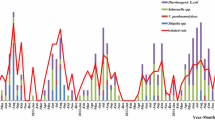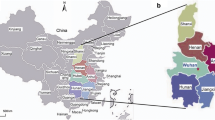Abstract
In this study, we investigated the long-term trends in the epidemiology and susceptibility of bacterial enteropathogens among children in a well-defined area of adequate health standards. The study included all children younger than 14 years of age treated for enteritis at Heraklion University General Hospital on the island of Crete during the 18-year period from January 1993 to December 2010. Stool specimens were tested for Salmonella, Shigella, Campylobacter, enteropathogenic Escherichia coli (EPEC), Yersinia, and Aeromonas species. Of the 33,032 stool samples from patients of any age, 2,912 (8.82%) were positive for bacterial enteropathogens. The 1,597 isolates from children were identified as S. enterica (42.3%), Campylobacter spp. (33.6%), EPEC (17.4%), Y. enterocolitica (5.82%), A. hydrophila (0.44%), and Shigella spp. (0.38%). A decline in prevalence was observed for all bacterial enteropathogens. Taken as a total, enteropathogens were susceptible to gentamicin, ceftriaxone, ciprofloxacin, co-trimoxazole, and amoxicillin in 98.8%, 88.0%, 83.0%, 67.1%, and 59.6%, respectively. During the study period, the susceptibility rates decreased for co-trimoxazole (p < 0.0001) and ciprofloxacin (p < 0.001), and increased for amoxicillin (p < 0.0001). Our findings suggest declining long-term trends in the prevalence of bacterial enteropathogens and changes in susceptibility rates to first-line antibacterial agents. These changing trends in the long-term morbidity and susceptibility call for ongoing surveillance and tailored management.

Similar content being viewed by others
References
Boschi-Pinto C, Velebit L, Shibuya K (2008) Estimating child mortality due to diarrhoea in developing countries. Bull World Health Organ 86:710–717
Meng CY, Smith BL, Bodhidatta L, Richard SA, Vansith K, Thy B, Srijan A, Serichantalergs O, Mason CJ (2011) Etiology of diarrhea in young children and patterns of antibiotic resistance in Cambodia. Pediatr Infect Dis J 30:331–335
Rosner BM, Stark K, Werber D (2010) Epidemiology of reported Yersinia enterocolitica infections in Germany, 2001–2008. BMC Public Health 10:337
Arsenault J, Ravel A, Michel P, Berke O, Gosselin P (2011) Do patients with recurrent episodes of campylobacteriosis differ from those with a single disease event? BMC Public Health 11:32
Scuderi G, Fantasia M, Niglio T (2000) Results of the three-year surveillance by the Italian SALM-NET System: human isolates of Salmonella serotypes. Eur J Epidemiol 16:377–383
Stevenson JE, Gay K, Barrett TJ, Medalla F, Chiller TM, Angulo FJ (2007) Increase in nalidixic acid resistance among non-Typhi Salmonella enterica isolates in the United States from 1996 to 2003. Antimicrob Agents Chemother 51:195–197
Velonakis EN, Markogiannakis A, Kondili L, Varjioti E, Mahera Z, Dedouli E, Karaitianou A, Vakalis N, Bethimouti K (2001) Evolution of antibiotic resistance of non-typhoidal salmonellae in Greece during 1990–97. Euro Surveill 6:117–120
Galanakis E, Bitsori M, Maraki S, Giannakopoulou C, Samonis G, Tselentis Y (2007) Invasive non-typhoidal salmonellosis in immunocompetent infants and children. Int J Infect Dis 11:36–39
Bitsori M, Galanakis E, Maraki S, Raissaki M, Velivassakis E, Sbyrakis S (2001) Invasive Salmonella virchow infection in childhood. Scand J Infect Dis 33:862–865
Galanakis E, Perdikogianni C, Maraki S, Giannoussi E, Kalmanti M, Tselentis Y (2006) Childhood Yersinia enterocolitica infection in Crete. Eur J Clin Microbiol Infect Dis 25:65–66
Perdikogianni C, Galanakis E, Michalakis M, Giannoussi E, Maraki S, Tselentis Y, Charissis G (2006) Yersinia enterocolitica infection mimicking surgical conditions. Pediatr Surg Int 22:589–592
Tassios PT, Markogiannakis A, Vatopoulos AC, Katsanikou E, Velonakis EN, Kourea-Kremastinou J, Legakis NJ (1997) Molecular epidemiology of antibiotic resistance of Salmonella enteritidis during a 7-year period in Greece. J Clin Microbiol 35:1316–1321
Ikumapayi UN, Antonio M, Sonne-Hansen J, Biney E, Enwere G, Okoko B, Oluwalana C, Vaughan A, Zaman SM, Greenwood BM, Cutts FT, Adegbola RA (2007) Molecular epidemiology of community-acquired invasive non-typhoidal Salmonella among children aged 2 29 months in rural Gambia and discovery of a new serovar Salmonella enterica Dingiri. J Med Microbiol 56:1479–1484
Chatzipanagiotou S, Economou M, Papavasileiou C, Ioannidis A, Ioannidou V, Papavasileiou E, Voyatzi A, Nicolaou C (2006) Incidence of bacterial and viral enteric pathogens in children with gastroenteritis over a one year-period, in Attica, Greece. Eur J Epidemiol 21:613–614
Kafetzis DA, Maltezou HC, Zafeiropoulou A, Attilakos A, Stavrinadis C, Foustoukou M (2001) Epidemiology, clinical course and impact on hospitalization costs of acute diarrhea among hospitalized children in Athens, Greece. Scand J Infect Dis 33:681–685
Jafari F, Garcia-Gil LJ, Salmanzadeh-Ahrabi S, Shokrzadeh L, Aslani MM, Pourhoseingholi MA, Derakhshan F, Zali MR (2009) Diagnosis and prevalence of enteropathogenic bacteria in children less than 5 years of age with acute diarrhea in Tehran children’s hospitals. J Infect 58:21–27
Thomson RB Jr (2007) Specimen collection, transport and processing: bacteriology. In: Murray PR, Baron EJ, Jorgensen JH, Landry ML, Pfaller MA (eds) Manual of clinical microbiology, vol 1, 9th edn. American Society for Microbiology (ASM) Press, Washington, DC, pp 291–333
Clinical and Laboratory Standards Institute (CLSI) (2009) Performance Standards for Antimicrobial Disk Susceptibility Tests; Approved Standard M2-A10. Tenth Edition. CLSI, Philadelphia, PA.
Andrews JM; BSAC Working Party on Susceptibility Testing (2008) BSAC standardized disc susceptibility testing method (version 7). J Antimicrob Chemother 62:256–278
Karsten C, Baumgarte S, Friedrich AW, von Eiff C, Becker K, Wosniok W, Ammon A, Bockemühl J, Karch H, Huppertz HI (2009) Incidence and risk factors for community-acquired acute gastroenteritis in north-west Germany in 2004. Eur J Clin Microbiol Infect Dis 28:935–943
Boga JA, Melón S, Nicieza I, De Diego I, Villar M, Parra F, De Oña M (2004) Etiology of sporadic cases of pediatric acute gastroenteritis in asturias, Spain, and genotyping and characterization of norovirus strains involved. J Clin Microbiol 42:2668–2674
Lorrot M, Bon F, El Hajje MJ, Aho S, Wolfer M, Giraudon H, Kaplon J, Marc E, Raymond J, Lebon P, Pothier P, Gendrel D (2011) Epidemiology and clinical features of gastroenteritis in hospitalised children: prospective survey during a 2-year period in a Parisian hospital, France. Eur J Clin Microbiol Infect Dis 30:361–368
Caprioli A, Pezzella C, Morelli R, Giammanco A, Arista S, Crotti D, Facchini M, Guglielmetti P, Piersimoni C, Luzzi I (1996) Enteropathogens associated with childhood diarrhea in Italy. The Italian Study Group on Gastrointestinal Infections. Pediatr Infect Dis J 15:876–883
Eurosurveillance editorial team (2010) Report published on factors contributing to the spread of Campylobacter in the European Union. Euro Surveill 15:19641
Jones TF, Angulo FJ (2006) Eating in restaurants: a risk factor for foodborne disease? Clin Infect Dis 43:1324–1328
Leman P, Strachan D (2001) A case–control study of food poisoning seen at an accident and emergency department. Lancet 358:387–388
Huhulescu S, Kiss R, Brettlecker M, Cerny RJ, Hess C, Wewalka G, Allerberger F (2009) Etiology of acute gastroenteritis in three sentinel general practices, Austria 2007. Infection 37:103–108
Naumova EN, Jagai JS, Matyas B, DeMaria A Jr, MacNeill IB, Griffiths JK (2007) Seasonality in six enterically transmitted diseases and ambient temperature. Epidemiol Infect 135:281–292
Samonis G, Maraki S, Christidou A, Georgiladakis A, Tselentis Y (1997) Bacterial pathogens associated with diarrhoea on the island of Crete. Eur J Epidemiol 13:831–836
Maraki S, Georgiladakis A, Tselentis Y, Samonis G (2003) A 5-year study of the bacterial pathogens associated with acute diarrhoea on the island of Crete, Greece, and their resistance to antibiotics. Eur J Epidemiol 18:85–90
Author information
Authors and Affiliations
Corresponding author
Rights and permissions
About this article
Cite this article
Maraki, S., Ladomenou, F., Samonis, G. et al. Long-term trends in the epidemiology and resistance of childhood bacterial enteropathogens in Crete. Eur J Clin Microbiol Infect Dis 31, 1889–1894 (2012). https://doi.org/10.1007/s10096-011-1517-2
Received:
Accepted:
Published:
Issue Date:
DOI: https://doi.org/10.1007/s10096-011-1517-2




